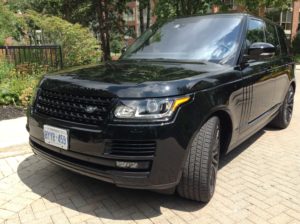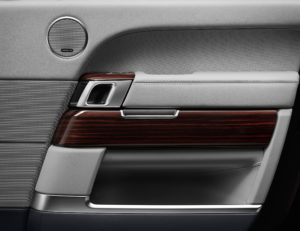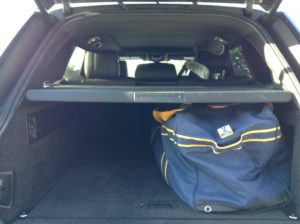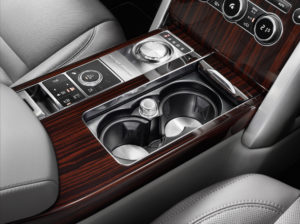Few vehicles stand out as international icons in their class. I enjoyed a week with one such icon, the 2016 Range Rover Diesel, HSE.

First impressions
This tall, wide vehicle looks ready for business with its tall stance, nearly upright windshield and elevated ground clearance. My Santorini Black tester’s offroad-ready looks were tempered, in my opinion, by low-profile road tires on rims that were almost as black as the vehicle. The overall impression is one of off-road readiness in an urbane package, the type of vehicle whose owner would employ a chauffeur in order to enjoy the ride (on paved roads, for the most part).
Interior
Touch the door handle and two things happen: the side mirrors swing out into position and lights shine down from underneath the mirrors, planting a sketch icon of the Range Rover on the ground to either side of the vehicle.
Illuminated “tread plates” i.e. door sills welcome you into the vehicle. Once you’re inside, luxury touches make themselves apparent anywhere you look.
Ebony leather seats in an ebony interior made me feel comfortable at once. The front seats can be adjusted up to 18 ways. Once you find the combination of seat and mirror positions that suit you, you can save them as one of three seating presets. Seat heating, cooling and seat massages up the comfort level.
My tester only offered heated seats to passengers in the rear, but there’s another option here. Range Rover uses the term “rear business seats” in its documentation to describe an environment for the stressed-out executive who gets chauffeured about in the Range Rover and needs the type of seats one finds in the business class section of transcontinental flights – 17 degrees of recline, bottle chiller, power-deployed tray, the works.

image courtesy Land Rover
Back to the model I drove: Narrow armrests flank the centre storage cubby. They each feature a knob used to adjust their height. I preferred keeping this armrest folded up and out of the way.
Polished wood and stitched leather make up surfaces on the steering wheel which is, naturally, power-adjustable using a small joystick on the steering column. The steering wheel heater switch is on the wheel itself, where it should be.
Grand black lacquered wood trim dots the interior, interspersed with leather and metal accents. The panoramic roof and blind work on separate ceiling-mounted switches. The buttons that open both glove compartments don’t sit on the doors themselves: rather, they make up two halves of a round button assembly just above the compartments, close to the centre of the vehicle.
In-cabin storage spaces abound. The centre cubby offers a deep “pocket” where passengers can keep their drinks chilled. The cupholder cover slides easily forward and back. Oddly, there’s no dedicated space for sunglasses, but the lined storage compartments under the handles in the front doors (closed and wood-veneered in the image below) ought to adequately protect one’s shades.

image courtesy Land Rover
Helping people into the vehicle is made easier by the access height adjustment controls, consisting of a button on the door (by the side view mirror switches) and buttons just ahead of the centre storage cubby.
Hockey bag test
My bag fit in lengthwise. I could have slid another bag beside it without lifting the hard privacy cover. That cover wasn’t easy to remove compared to fabric, roll-away covers, but it did serve as a handy shelf on several occasions.

The power liftgate opens in two parts: the upper glass portion and a lower lip that you can leave up to simulate the back end of a car’s trunk.
In-vehicle technology
The Range Rover bristles with modern technology, but its designers kept that technology from being overly conspicuous. They created interest with the pop-up gear selector and terrain response switches (more on these below) that recede when they aren’t in use, resulting in a flatter, cleaner look between the two front seats that complements the cupholder cover.
The instrument cluster is one long screen that adapts as needed. The tachometer and speedometer appear where they ought to, with an information screen separating the two.
Configuring the Range Rover’s behaviour is done using a set of buttons grouped in a circle under the driver’s left thumb. Steering wheel controls are pleasingly similar on both sides of the wheel. Buttons under the vehicle configuration controls are for using the phone. The right-side buttons enable cruise control and heating for the steering wheel.
Cruise control information appears in several places, but my favourite is the green arrow that travels from 0 km/h around the “dial” to the current speed when you press the “Set” button. It’s one of several pleasing design features this Range Rover shares with the Jaguar F-Type I drove last fall.
I didn’t need to look at the instrument cluster screen often, thanks to the heads-up display that projected speed and other necessary information inches “above” the front of the hood. There is no mirror for this assembly. The system projects the information onto the front windshield. I quickly adjusted the height of this HUD using the aforementioned buttons on the steering wheel to find and change the setting in the instrument panel menu.
The requisite touch screen provides access to all the customary automotive gadgetry. It drives the Meridian premium surround sound system. With its many speakers driven by 825 watts of power, the pickiest audiophile would be hard pressed to find fault with the mellifluous sounds this system can produce.
The navigation system proved a little slow accepting my typing when I entered destinations. While driving, the touchscreen information almost kept up with the “next step” flashed by the heads-up display, which I depended upon more as I got used to the system.
Oddly, while I could pair a Bluetooth device quickly, I could not immediately figure out how to change channels on the radio. Once I read the quick start guide, it made sense. Still, I fault the vehicle here. Radio tuning knobs have been around for about as long as radios have, and for good reason.
Driving
The 3.0-litre TDV6 turbocharged diesel engine, a recent addition to the Range Rover line, produces 254hp. This motor delivers passing power when you need it on the highway, and its integration with the rest of the Rover’s mechanicals kept the ride buttery smooth and civilized.
Those who want to use this vehicle’s towing capability will be glad to know that it produces 440 lb-ft @ 1,750 rpm.
This Rover comes equipped with steering-wheel-mounted paddle shifters for drivers who want to control the gearbox themselves. I used it during my first drive to run through each of the eight gears on my own.
I hate to say anything negative about this vehicle, but paddle shifters on a Range Rover make about as much sense as basketball shoes on a bulldozer. This is a heavy, capable vehicle that has more smarts than any of its drivers ever will, and it can choose the right gear all on its own, thank you very much, and will never need a driver to do so on a race track.
The automatic transmission gear selector is a dial that sits recessed in the centre console when the vehicle is off. Hit the Start Engine button and the dial smoothly rises an inch, so you can choose P, R, N, D and S by twisting the dial. The paddle-shifter mode (“S”) calls for a press of the dial before you twist to choose it.

image courtesy Land Rover
Range Rover is designed as an off-road vehicle, and this vehicle offers several driving setups from a second dial (the terrain response selector) located between the gear selector and the centre storage cubby. When this dial is recessed, it’s in automatic mode and it determines the most suitable vehicle behaviour for the conditions. Press the dial down and it pops up so you can manually select General, Grass-Gravel-Snow, Mud-Ruts, Sand and Rock Crawl. (The manual recommends Rock Crawl when taking the Range Rover through water. This vehicle can wade through rivers up to three feet deep.)
All sorts of driving technology goodies seem to be on board. Blind spot monitoring lights up the relevant door mirror if a vehicle is in your blind spot on its side.
The Rover also alerted me to vehicles I was closing in on. It certainly works overtime to keep drivers alert to their surroundings. Drivers can press an icon next to the touchscreen to have a 360-degree camera take over the screen.
The Rover also detects suitable parking spots via the Park Assist feature. It seems to choose shorter spaces than I would pick on my own, but it probably steers better into these spots than I can. The Rover stands ready to help with both parallel and angle parking.
I made use of adaptive cruise control, a feature which elicits my usual complaint on any vehicle that has this feature: the longest distance I could choose between the Range Rover and the vehicle ahead is about two seconds, which driving school taught me is the minimum safe following distance. I don’t know why automakers don’t lengthen these following distances and, in fact, allow for shorter distances. Sure, the vehicle is smart and can probably react in time (I didn’t put the Rover’s smarts or reactions to the test) but longer following distances would keep the ride, including required decelerations, smoother even on this techno-advanced SUV.
Sensors also warned me (several times) of vehicles slowing down suddenly ahead. Warning sounds disrupted the calm as a red triangle flashed on the instrument cluster.
If your regular parking areas are as tight as, say, the entry/exit ramp to my condo parking garage, be ready to hear warnings sound regularly. It’s just part and parcel of the big, wide body on the Rover.
I appreciated the intelligent stop/start technology killing the engine when it was stopped at a red light or stop sign (unless it had to run other vehicle systems). Several times, it made the intelligent, labour-saving move of killing the engine after I put the Rover in park and activated the electronic parking brake.
Pricing
The 2016 Range Rover TDV6 Diesel, HSE starts at $108,490 MSRP. The vehicle I drove, with options, fees and taxes, carries an MSRP of $131,515.